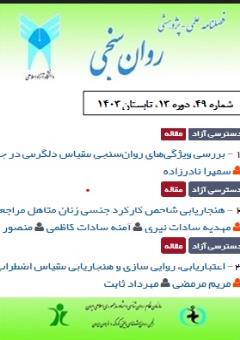استانداردسازی پرسشنامه کنترل عواطف در نوجوانان 15سال به بالادرشهرتهران
محورهای موضوعی : روان سنجی
1 - دانشگاه ازاد اسلامی واحد الکترونیک
کلید واژه: کلید واژگان: استانداردسازی, عواطف, کنترل عواطف,
چکیده مقاله :
هدف از پژوهش استانداردسازی پرسشنامه کنترل عواطف بود. روش پژوهش از نوع توسعه ای -تحلیلی بود. جامعه آماری را کلیه نوجوانان دختر و پسر 15 سال به بالا ساکن در شهر تهران در سال 1400 تشکیل دادند. نمونه آماری بر اساس فرمول کوهن، مانیون و موریسون(2000) به تعداد 300 نفر به روش نمونهگیری در دسترس انتخاب شدند. جهت جمع آوری دادهها از مقیاس کنترل عواطف ویلیامز و همکاران(1997) استفاده شد. نتایج نشان داد، مقیاس اضطراب و عاطفه مثبت مقدار آلفای کرونباخ کمتر از 70/0 بود که با حذف سوالات 14 و 16 از مقیاس اضطراب و سوال 2 از مقیاس عاطفه مثبت به مقدار قابل قبول رسید. بار عاملی استاندارد برای تک تک سؤالات هر عامل مشخص شدند که باید میزان ارتباط هر سؤال با عامل زیربنایی آن، بیشتر از ارتباط آن با عامل های دیگر باشد، با حذف سوالات 28،22 و 6 از مقیاس خشم، سوال 1 از مقیاس عاطفه مثبت و سوال 3 از مقیاس افسردگی، همه سؤالات به طور معنادار به عامل زیربنایی خود مرتبط هستند و میتوان گفت که مدل اندازه گیری طی ارزیابی شاخصهای جزئی مطلوب بود.مقادیر قابل قبول بارهای عاملی نیز نشان دهنده برازش مناسب مدل بودند. با توجه به مقدار بارهای عاملی که همگی بالاتر از 40/0 است ضریب مسیر معنادار بود. و در نهایت مقدار GOF برابر با 682/0 است که نشان از برازش خوب مدل را داشت.
The purpose of this study was to standardize the Emotion Control Questionnaire. The research method was developmental-analytical. The statistical population consisted of all adolescent girls and boys aged 15 years and older living in Tehran in 1400. Statistical sample based on the formula of Cohen, Manion and Morrison (2000) 300 people were selected by convenience sampling method. The Emotion Control Scale of Williams et al. (1997) was used to collect data. The results showed that the Anxiety and Positive Emotion Scale of Cronbach's alpha was less than 0.70 which reached an acceptable value by removing questions 14 and 16 from the Anxiety Scale and Question 2 from the Positive Emotion Scale. The standard factor load for each question of each factor was determined that the relationship between each question and its underlying factor should be more than its relationship with other factors, by removing questions 28, 22 and 6 from the anger scale, question 1 from the positive emotion scale And question 3 of the Depression Scale, all questions are significantly related to their underlying factor and it can be said that the measurement model was desirable during the evaluation of partial indicators. Acceptable values of factor loads also indicated a good fit of the model. Due to the amount of factor loads, all of which are higher than 0.40, the path coefficient was significant. Finally, the GOF value is equal to 0.682, which indicates a good fit of the model.

